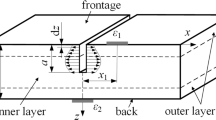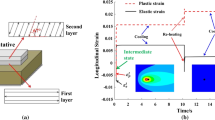Abstract
This paper studied the influence of the initial residual stress on the dimensional stability of manufactured components. Although residual stresses are assumed to be in self-equilibrium within a solid that is not subjected to an external load, most manufactured products will be affected by external forces during service. Therefore, this study allowed for the combined effects of the initial residual stress and external forces on the excessive deformation of a prestressed body. On the basis of the virtual work principle, we developed a new analytical model for predicting the excessive deformation of a prestressed body under an applied load. The proposed model was validated by means of the finite difference method, and we made a comparison with an existing model from the literature, which was developed to predict the excessive deformation of a thin aluminum plates with the machining-induced residual stress. The computational results showed that the proposed method had 10% greater predictive accuracy than previous models available in the work.



Similar content being viewed by others
Abbreviations
- T 0 :
-
Residual stress the second Piola-Kirchhoff stress tensor in the undeformed frame
- N :
-
Outward unit normal vector of area element in the undeformed frame
- E :
-
Strain tensor the undeformed frame
- σ :
-
The Cauchy stress in the deformed/current frame
- e :
-
Euler strain tensor in the deformed/current frame
- I :
-
Identity matrix
- F :
-
The material deformation gradient tensor
- I :
-
The displacement in the deformed/current frame
- f(x) :
-
Body force in the deformed/current frame
- g(x) :
-
Surface force in the deformed/current frame
- τ :
-
The applied stress unrelated to the residual stress
- Ω :
-
The total stress in the loaded but undeformed frame
- T :
-
The initial stress in the deformed frame
- t :
-
The applied stress in the deformed frame
- n :
-
Outward unit normal vector of area element in the deformed frame
- W :
-
Strain energy density function
- C IJKL :
-
Moduli
- ci :
-
Coefficient
- h :
-
Depth
References
Brinksmeier E, Cammett JT, König W, Leskovar P, Peters J, Tönshoff HK (1982) Residual stresses — measurement and causes in machining processes. CIRP Ann 31(2):491–510
Withers PJ, Bhadeshia HKDH (2001) Residual stress. Part 2 – nature and origins. Mater Sci Technol 17(4):366–375
Johnson EM, Watkins TR, Schmidlin JE, Dutler SA (2001) A benchmark study on casting residual stress. Metall Mater Trans A 43(5):1487–1496
Inoue Y, Motoyama Y, Takahashi H, Shinji K, Yoshida M (2013) Effect of sand mold models on the simulated mold restraint force and the contraction of the casting during cooling in green sand molds. J Mater Process Tech 213(7):1157–1165
Wu T, Coret M, Combescure A (2008) Numerical simulation of welding induced damage and residual stress of martensitic steel 15-5PH. Int J Solids Struct 45(18–19):4973–4989
Dattoma V, De Giorgi M, Nobile R (2006) On the evolution of welding residual stress after milling and cutting machining. Comput Struct 84(29–30):1965–1976
García Navas V, Ferreres I, Marañón JA, Garcia-Rosales C, Gil Sevillano J (2008) Electro-discharge machining (EDM) versus hard turning and grinding—comparison of residual stresses and surface integrity generated in AISI O1 tool steel. J Mater Process Tech. 195(1–3):186–194
Fetullazade E, Akyildiz HK, Saritas S (2010) Effects of the machining conditions on the strain hardening and the residual stresses at the roots of screw threads. Mater Design. 31(4):2025–2031
Daoud M, Chatelain JF, Bouzid A (2017) Effect of rake angle-based Johnson-Cook material constants on the prediction of residual stresses and temperatures induced in Al2024-T3 machining. Int J Mech Sci 122:392–404
Wan M, Ye X-Y, Yang Y, Zhang W-H (2017) Theoretical prediction of machining-induced residual stresses in three-dimensional oblique milling processes. Int J Mech Sci 133:426–437
Capello E (2006) Residual stresses in turning. J Mater Process Tech. 172(3):319–326
Larue J, Daniewicz S (2007) Predicting the effect of residual stress on fatigue crack growth. Int J Fatigue 29(3):508–515
Ihara R, Katsuyama J, Onizawa K, Hashimoto T, Mikami Y, Mochizuki M (2011) Prediction of residual stress distributions due to surface machining and welding and crack growth simulation under residual stress distribution. Nucl Eng Des 241(5):1335–1344
Kim J-C, Cheong S-K, Noguchi H (2013) Evolution of residual stress redistribution associated with localized surface microcracking in shot-peened medium-carbon steel during fatigue test. Int J Fatigue 55:147–157
Yang X, Richard Liu C, Grandt AF (2002) An experimental study on fatigue life variance, residual stress variance, and their correlation of face-turned and ground Ti 6Al-4V samples. J Manuf Sci Eng 124(4):809–819
Choi Y (2009) A study on the effects of machining-induced residual stress on rolling contact fatigue. Int J Fatigue 31(10):1517–1523
Wang M, Zhang P, Fei Q, Guo F (2019) Computational evaluation of the effects of void on the transverse tensile strengths of unidirectional composites considering thermal residual stress. Compos Struct 227:111287
Qian S, Liu F, Ma M, Chen G, Liu Z, Li Y (2019) Mechanical strength enhancement of low temperature co-fired multilayer ceramic substrates by introducing residual stress. Ceram Int 45(8):10982–10990
Li ZL, Chen D, Li YJ, Wang XQ, Kang J, Yuan G (2019) A novel process involving multiple strengthening mechanisms for production of low-residual stress X80 pipe steel based on ultra-fast cooling. Mater Lett 257
Lesyk DA, Martinez S, Mordyuk BN, Dzhemelinskyi VV, Lamikiz А, Prokopenko GI (2020) Post-processing of the Inconel 718 alloy parts fabricated by selective laser melting: effects of mechanical surface treatments on surface topography, porosity, hardness and residual stress. Surface Coat Technol 381
Sun T, Reynolds AP, Roy MJ, Withers PJ, Prangnell PB (2018) The effect of shoulder coupling on the residual stress and hardness distribution in AA7050 friction stir butt welds. Mater Sci Eng A 735:218–227
Huber N, Heerens J (2008) On the effect of a general residual stress state on indentation and hardness testing. Acta Mater 56(20):6205–6213
Sosa AD, Echeverría MD, Moncada OJ, Sikora JA (2007) Residual stresses, distortion and surface roughness produced by grinding thin wall ductile iron plates. Int J Mach Tool Manu 47(2):229–235
Sen G, Sampathkumaran P, Nadig DS, Manjunatha R, Seetharamu S (2009) Effect of residual stresses and metallographic stability on the over all performance of integral diaphragm material. Mat Sci Eng A-Struct 517(1–2):85–90
Brinksmeier E, Sölter J, Grote C (2007) Distortion engineering – identification of causes for dimensional and form deviations of bearing rings. CIRP Ann Manuf Technol 56(1):109–112
Brinksmeier E, Sölter J (2009) Prediction of shape deviations in machining. CIRP Ann Manuf Technol 58(1):507–510
Gulpak M, Sölter J, Brinksmeier E (2013) Prediction of shape deviations in face milling of steel. Procedia CIRP 8:15–20
Zijlstra G, Groen M, Post J, Ocelík V, De Hosson JTM (2016) On the role of the residual stress state in product manufacturing. Mater Design 105:375–380
Jiang Z, Liu Y, Li L, Shao W (2014) A novel prediction model for thin plate deflections considering milling residual stresses. Int J Adv Manuf Tech. 74(1–4):37–45
Gao H, Zhang Y, Wu Q, Song J (2017) An analytical model for predicting the machining deformation of a plate blank considers biaxial initial residual stresses. Int J Adv Manuf Tech 93(1–4):1473–1486
Madariaga A, Perez I, Arrazola PJ, Sanchez R, Ruiz JJ, Rubio FJ (2018) Reduction of distortions in large aluminium parts by controlling machining-induced residual stresses. Int J Adv Manuf Tech. 97(1–4):967–978
Hoger A (1986) On the determination of residual stress in an elastic body. J Elast 16(3):303–324
Hoger A (1985) On the residual stress possible in an elastic body with material symmetry. Arch Ration Mech An. 88(3):271–289
Biot MA (1939) Non linear theory of elasticity and the linearized case for a body under initial stresses. Philos Mag 27:468–489
Kolpakov DAG (2004) Stressed composite structures. Springer
Garg N (2007) Effect of initial stress on harmonic plane homogeneous waves in viscoelastic anisotropic media. J Sound Vib 303(3–5):515–525
Shams M, Destrade M, Ogden RW (2011) Initial stresses in elastic solids: constitutive laws and acoustoelasticity. Wave Motion 48(7):552–567
Merodio J, Ogden RW, Rodríguez J (2013) The influence of residual stress on finite deformation elastic response. Int J Nonlin Mech 56:43–49
Tao M, Li X, Wu C (2012) Characteristics of the unloading process of rocks under high initial stress. Comput Geotech 45:83–92
Fung YC (1993) A first course in continuum mechanics. Pearson
Fung YC (2001) P.T., Classical and computational solid mechanics. World Scientific Publishing Co Pte Ltd
Cloud LPLMJ (2003) Tensor analysis. World Scientific Publishing Co Pte Ltd
Hjelmstad KD (2005) Fundamentals of structural mechanics. Springer US, p 480
Irgens F (2008) Continuum mechanics. Springer
Javier Bonet RDW (2008) Nonlinear continuum mechanics for finite element analysis, 2nd edn. Cambridge University Press
Rudnicki JW, Fundamentals of continuum mechanics. 1st ed. (2015) John Wiley & Sons. Ltd.
Huang X, Liu Z, Xie H (2013) Recent progress in residual stress measurement techniques. Acta Mech Solida Sin 26(6):570–583
Withers PJ, Turski M, Edwards L, Bouchard PJ, Buttle DJ (2008) Recent advances in residual stress measurement. Int J Pres Ves Pip 85(3):118–127
Fengyun Wang KM, Li B (2018) Prediction of residual stress fields from surface stress measurements. Int J Mech Sci 140:68–82
Thomas JW (1995) Numerical partial differential equations: finite difference methods. Springer
Wawszczak R, Baczmański A, Marciszko M, Wróbel M, Czeppe T, Sztwiertnia K, Braham C, Berent K (2016) Evolution of microstructure and residual stress during annealing of austenitic and ferritic steels. Mater Charact 112:238–251
Janez Grum SB, Zupančič M (2001) Influence of quenching process parameters on residual stresses in steel. J Mater Process Tech. 114(1):57–70
Mackerle J (2003) Finite element analysis and simulation of quenching and other heat treatment processes. Comput Mater Sci 27(3):313–332
Li H, Zhao G, He L (2008) Finite element method based simulation of stress–strain field in the quenching process. Mater Sci Eng A 478(1–2):276–290
Nallathambi AK, Kaymak Y, Specht E, Bertram A (2010) Sensitivity of material properties on distortion and residual stresses during metal quenching processes. J Mater Process Tech. 210(2):204–211
Lados DA, Apelian D, Wang L (2010) Minimization of residual stress in heat-treated Al-Si-Mg cast alloys using uphill quenching: mechanisms and effects on static and dynamic properties. Mater Sci Eng A. 527(13-14):3159–3165
Feng Q, Jiang C, Xu Z (2013) Residual stress relaxation of shot-peened deformation surface layer on duplex stainless steel under applied loading. J Mater Eng Perform 23(2):408–412
Benedetti M, Fontanari V, Scardi P, Ricardo CLA, Bandini M (2009) Reverse bending fatigue of shot peened 7075-T651 aluminium alloy: the role of residual stress relaxation. Int J Fatigue 31(8–9):1225–1236
Frija M, Hassine T, Fathallah R, Bouraoui C, Dogui A (2006) Finite element modelling of shot peening process: prediction of the compressive residual stresses, the plastic deformations and the surface integrity. Mater Sci Eng A 426(1–2):173–180
Wang J-S, Hsieh C-C, Lin C-M, Chen E-C, Kuo C-W, Wu W (2014) The effect of residual stress relaxation by the vibratory stress relief technique on the textures of grains in AA 6061 aluminum alloy. Mater Sci Eng A 605:98–107
Wang J-S, Hsieh C-C, Lin C-M, Kuo C-W, Wu W (2013) Texture evolution and residual stress relaxation in a cold-rolled Al-Mg-Si-Cu alloy using vibratory stress relief technique. Metall Mater Trans A 44(2):806–818
Walker C (2011) A theoretical review of the operation of vibratory stress relief with particular reference to the stabilization of large-scale fabrications. Proceedings of the Institution of Mechanical Engineers, Part L: Journal of Materials: Design and Applications 225(3):195–204
Funding
This work was funded by the National High Technology Research and Development Program of China (No. 2012AA040702, No. 2012AA040703).
Author information
Authors and Affiliations
Corresponding author
Additional information
Publisher’s note
Springer Nature remains neutral with regard to jurisdictional claims in published maps and institutional affiliations.
Rights and permissions
About this article
Cite this article
Zhu, Y., Mao, K. & Yu, X. A general model for prediction of deformation from initial residual stress. Int J Adv Manuf Technol 109, 1093–1101 (2020). https://doi.org/10.1007/s00170-020-05683-2
Received:
Accepted:
Published:
Issue Date:
DOI: https://doi.org/10.1007/s00170-020-05683-2




